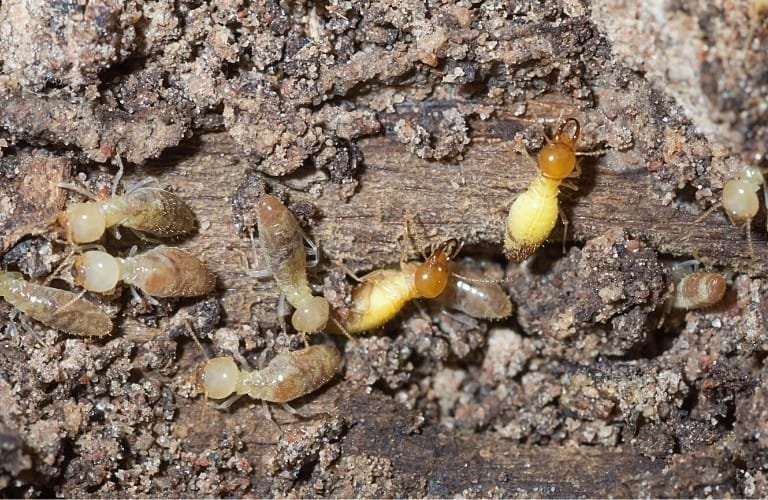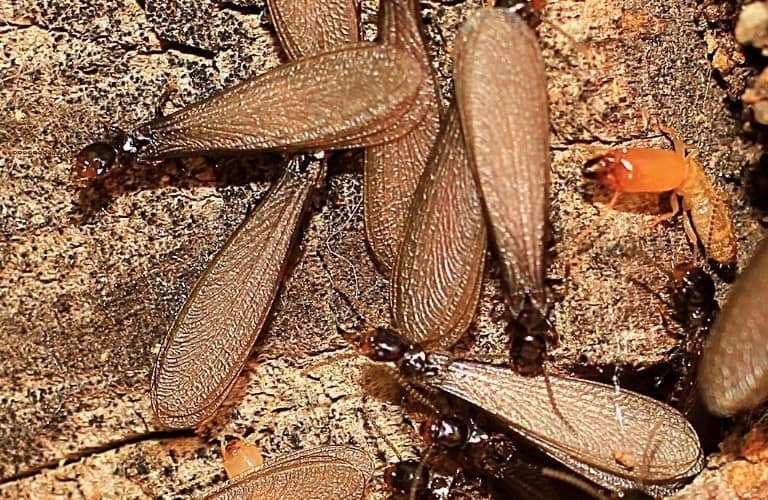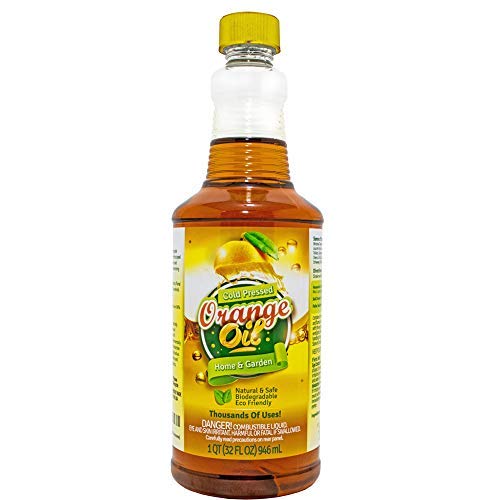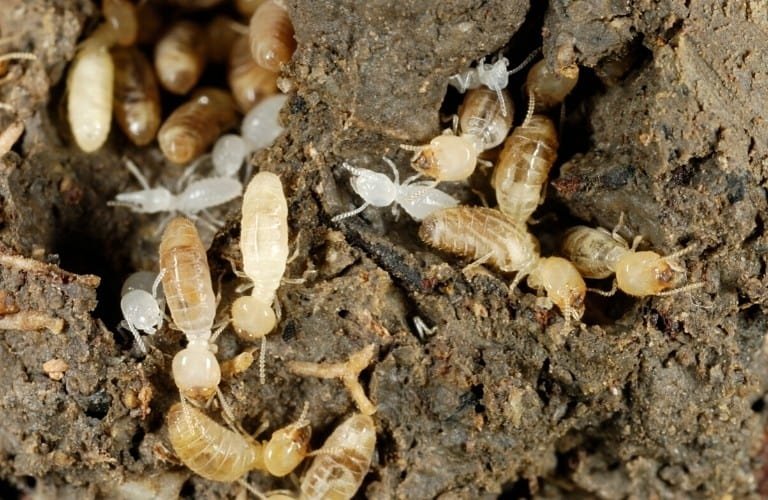Termites are little doomsday critters for homeowners. They chew through wood and build nests in it that cause structural damage to homes.
They’re one of the last insects you want to see.
How do you get rid of termites? For small or new infestations, natural methods, such as orange oil, vinegar, or nematodes, may be used. Pesticide products, such as aerosol foam, granules, sprays, and stakes will kill termites, but for large problems, it’s best to enlist the help of a professional.
Let’s take a look at how to identify termites and what to do once you spot them.
After all, the more you know, the better prepared you’ll be to win the battle against these destructive pests.
Don’t miss out on important termite facts, prevention guidelines, and elimination tactics! Click here to access all of our termite articles and key tips.
Identifying Termites
Termites are in the same order as cockroaches – Blattodea. That means that they have similar appearances and attributes to cockroaches.
However, they look a lot like ants and are often confused with ants.
Below is a picture of a termite. Its head looks like an ant, except for the straight antennae, but the body more resembles that of a cockroach.
Termites are commonly confused with ants when they’re seen with wings.
The winged termites are in the nuptial stage, which means the ones with wings have left the nest to find other termites to mate with.
Ants also have specific members of the colony known as alates that have wings and go out to mate.
Learn how to tell whether you’re dealing with termites or flying ants in our article “Termites Vs. Flying Ants.”
As you can see in the image below, the wings of termites are long and slender. The ends of the wings will usually match up.
Ants, however, don’t have congruent wings; instead, the bottom wings are shorter than the top.
Termites build nests and will chew through wood to expand their colony.
They’ll also build mud tunnels in places that don’t have wood so they can safely get from one place to another.
Unlike certain species of ants, termites are not prone to biting, and in the rare instance that a bite occurs, it is only mildly irritating.
Removal Methods
| Method | Estimated
Cost |
Natural | Odor
Free |
| Orange oil | $25 or less | ✅ | |
| Vinegar | $10 or less | ✅ | |
| Cayenne pepper | $10 or less | ✅ | |
| Wet cardboard | Free or <$10 | ✅ | |
| Sunlight/UV light | Over $100 (UV lamp) | ✅ | ✅ |
| Nematodes | $35 | ✅ | ✅ |
| Aerosol foam | $10 | ||
| Granules | $45 | ||
| Pesticide spray | $25 | ||
| Bait stations | $40 | ✅ |
The Best Way to Eliminate Termites
The best way to get rid of termites is to use orange oil. It’s toxic to termites and will kill them almost immediately when you spray it on them.
To use orange oil effectively:
- Make sure orange oil won’t damage the surfaces you’ll spray it on. Essential oils can damage certain surfaces.
- If you’re using pure orange oil, add the oil to a spray bottle and mix with water to dilute it.
- Spray the oil on areas where you find termites.
- Continue to spray the oil each week to clear all of them away and also as a preventative measure.
Basic Guidelines
Preventing termites is crucial since they’re so destructive to homes and other wooden structures.
Significant termite damage can eventually lead to structural damage that can become a safety risk. Fortunately, termite prevention is fairly easy.
Just remember to plan a termite inspection at least once a year, even if you’re diligent with prevention measures.
This article shows you how to thoroughly inspect your home for termite infestations.
Plan Ahead
This step isn’t so helpful for existing homes, but if you have the opportunity to build a new home or make major improvements to your current home, try the following steps:
- Eliminate wood contact with soil: New homes have the opportunity to fully protect the wood with coverings or foundation so it doesn’t touch the soil. This can be done for existing homes, but it involves a lot of digging.
- Create drainage: Make sure the house has good drainage so water goes away from the house instead of collecting near it. This is easier to do when a house is being built, but it is possible to fix a current situation too.
- Termite mesh: Termite mesh is made of stainless steel and holes small enough that termites can’t make it through. It’s better for this to be installed while a home is being built to make sure it’s installed correctly and efficiently.
Remove Moisture
Soggy wood is the most desirable for termites because it’s easy to chew through and comfortable for them to stay in.
If you notice that water pools around your home when it rains or you water your yard, you need to direct the water elsewhere.
You can do this by building up dirt around your home or digging trenches to guide the water away.
You can also control moisture levels by choosing landscaping that doesn’t retain water. Sand and rocks drain water quickly.
If you have flowerbeds against your home, try decorating with sandy soil, rocks, and sun-loving succulents that can handle a bit of a drought.
Check for Nests
Look around your home periodically for signs of termites. If you see a nest, mud trails, or wood damage, it’s time to start treating for termites.
The termite colony will only grow bigger, so it’s best to catch them sooner rather than later to prevent an infestation.
Natural Solutions to Get Rid of Termites
Many people call an exterminator as soon as they see the first sign of damage.
(Is the presence of one termite a sure sign of infestation? Find the answer here.)
If there’s only a small population or making the call isn’t convenient, there are plenty of natural solutions you can try at home.
Most of them won’t cost much because you probably already have what you need in your home.
Indoor Infestations
Termites easily find their way inside homes.
They come from the outside and chew their way inside, and that’s how you find their mud trails going up your basement or kitchen walls.
Luckily there are some natural solutions that are perfectly safe to use in your home that won’t be too annoying to use.
Orange Oil
Orange oil contains d-limonene, which is highly toxic to termites and other insects.
The oil comes from the peel and can be used to kill termites on the spot.
You can buy the oil in a bottle since that’s its most potent form. Green Gobbler Cold Pressed Orange Oil is a good choice.
It’s orange oil mixed with a little bit of coconut oil to make it easier to spread.
It’s incredibly effective against termites and only contains natural ingredients, so it’s safe to use inside your home around your family.
The fruity scent is pleasant, so you don’t have to worry about bad smells in the house.
Vinegar
White vinegar is something you probably already have on hand, and it’s an effective form of termite control.
When mixed with lemon juice, it’ll kill termites on contact.
Juice two lemons and mix it with about half a cup of vinegar in a spray bottle. Spray it directly onto termites and in the areas where you see them.
Spray every few days until you no longer see any termites. You can also spray this outside, so be sure to cover the entire infested area.
If you don’t have vinegar in your pantry, Natural Distilled White Vinegar is a great choice. It’s a 2-pack so you’ll be able to treat termites long-term if necessary.
Cayenne Pepper
Cayenne pepper contains a chemical compound called capsaicin, which is responsible for giving the pepper its spice.
While it can burn a human’s eyes and turn their face red, it will damage a termite’s nervous system and kill them.
To make use of cayenne pepper, sprinkle it wherever you see termites crawling. The closer you can get to the nest, the better.
You can also mix it with vegetable oil to create a paste to help it stick to the termites better.
Whichever way you choose to apply it, you should leave it for about five days to give it enough time to be effective.
If you don’t already have cayenne pepper at home, Cayenne Pepper is a great choice to buy.
It’s a bulk container, so you’ll have plenty of powder to cover large areas for several weeks if necessary.
Outdoor Infestations
In the wild, termites chew up trees, which means you’ll be able to find them outside.
In suburban areas, you’re more likely to find them indoors, but there are many ways you can treat them outdoors if you see them.
Wet Cardboard
Soggy wood is the ideal place for termites, but soggy cardboard is equally attractive.
If you spot termites on or in your house, you can lure them outside to destroy them with wet cardboard.
Allow a piece of cardboard to soak for a few minutes, then place it on the ground near the termites. They’ll soon swarm to it and start chewing through it.
Once this happens, dispose of the termites by burning the cardboard.
It’s a bit gruesome, but it’s a guaranteed way to make sure they can’t make their way back to your home.
Any cardboard will work, but if you can’t find any, Corrugated Cardboard Sheets work perfectly because they’re big enough to handle a lot of termites but small enough to easily carry once the termites are on it.
Of course, you can always use the boxes that come with other products we recommend on the list.
Sunlight
Sunlight is arguably the most natural way you can get rid of termites.
Termites typically live underground, in nests, or in walls, all of which are out of the sun.
Too much sun will kill termites because it’s too hot for them.
If you’re able to uncover an infested area of your home and expose it to sunlight, it might cause termites to die.
However, keep in mind that it might just encourage them to move. This method requires prolonged exposure to be effective, and they’ll want to move since the heat is uncomfortable.
You can use the previously mentioned wet cardboard method to lure them out into the sun. On a hot summer day, it shouldn’t take long for them to die.
You can also use a UV light to kill them, such as the COOSPIDER 36W UV Lamp w/Remote Control.
You can place this lamp near the termites and the UV rays it emits will kill them.
Be careful when using this product because prolonged exposure to UV rays can harm your skin, so it’s best to use this when you’re not in the area.
Nematodes
Nematodes are a type of worm that can be found all over the world.
It’s unclear how many different species there are because some of them are microscopic sizes while others can measure up to 3 feet long.
You can buy nematodes to use as a natural defense against termites. They’re tiny, but in large numbers, they can quickly wipe out a termite colony.
BioLogic Scanmask Beneficial Nematodes will cover about 200 square feet. You can easily apply them with water or by sprinkling them in the area.
It may seem like an icky form of pest control, but the nematodes can’t hurt you or your property.
If nature provides a way to control itself, it’s best to utilize it as often as we can.
They also kill a large variety of other pests, and they don’t hurt plants, so they can be a great way to control pests in the garden.
Pesticide Solutions to Get Rid of Termites
Sometimes natural methods don’t seem to work.
There are several variables that can cause a natural method to not work for someone despite it working for many other people.
Pesticides are efficient and convenient, but they should only be used after you’ve tried natural methods since they can hurt the environment, people, and pets.
Aerosol Foam
Aerosol foam is perfect for reaching those tiny nooks and crannies termites dig out for themselves.
The product comes out as an aerosol spray, but once it lands it starts to expand and will fill all the little spaces that are hard to reach.
Spectracide Termite Killing Foam can be used indoors and outdoors for both dry wood and damp wood termites, and it won’t stain the surfaces.
The foam will kill termites on contact and will continue to kill as long as it’s around.
This product also kills carpenter bees (find prevention and elimination methods for carpenter bees here), which are considered to be pests but are also beneficial pollinators.
Be careful when using this outdoors if you also have bees in the area.
Granules
Granules are the best option if you want to create a border around your home that will kill termites.
You can sprinkle it around your home, wood piles, or other areas outside that have termites.
BioAdvanced Termite Killer Granules is easy to use – after you sprinkle it, water it so it’ll activate, and then you’re done. It will cover up to 200 square feet and will last for a few weeks.
Spray
Sprays are another type of pesticide that will kill on contact.
You can spray the perimeter of your home so it will kill any termite that walks across it, or you can spray the termites or mud tunnels directly.
BioAdvanced Ant & Termite Killer Plus comes with a battery-powered sprayer to make application easy.
You can use it indoors or outdoors as long as you have good ventilation.
The special formula won’t drip and it should stick around for a few weeks unless it rains.
Bait Stations
Bait stations consist of spikes that are placed within the ground around your home’s perimeter.
They can be filled with bait and pesticide products, which foraging termites will bring back to the nest and share with the colony.
Many also have an alert feature that signals when termite activity is detected.
Spectracide Termite Stakes come with 15 prefilled pesticide bait stakes that feature a pop-up indicator that lets you know that termites are in the area.
With a fast installation time and a money-back guarantee, you can use these stakes with confidence.
Be sure to check out all of our bait station recommendations found in this article to see which option would be most effective for your home.
Safety Precautions When Using Pesticides
When handling pesticides, you should always protect your skin and face by covering them up.
Wear gloves, long sleeves, and goggles, and be sure not to breathe in the fumes when you’re applying it.
Pesticides contain harmful chemicals that can damage or injure all living things, including people, pets, beneficial insects, and plants.
Water can cause the chemicals to run off and mix with local bodies of water. Be cautious and responsible when using dangerous chemicals.
Make sure children and pets aren’t in the area, allow plenty of ventilation, and consider where the chemicals may end up.
When to Call a Professional Exterminator
If you have any reservations about using pesticides or are dealing with a large infestation, contact your local professional exterminator.
They’ll size up the situation and decide the best way to handle your termite infestation.
Some exterminators specialize in termite control, so if you have one of those near you, you should probably consider consulting them first.














